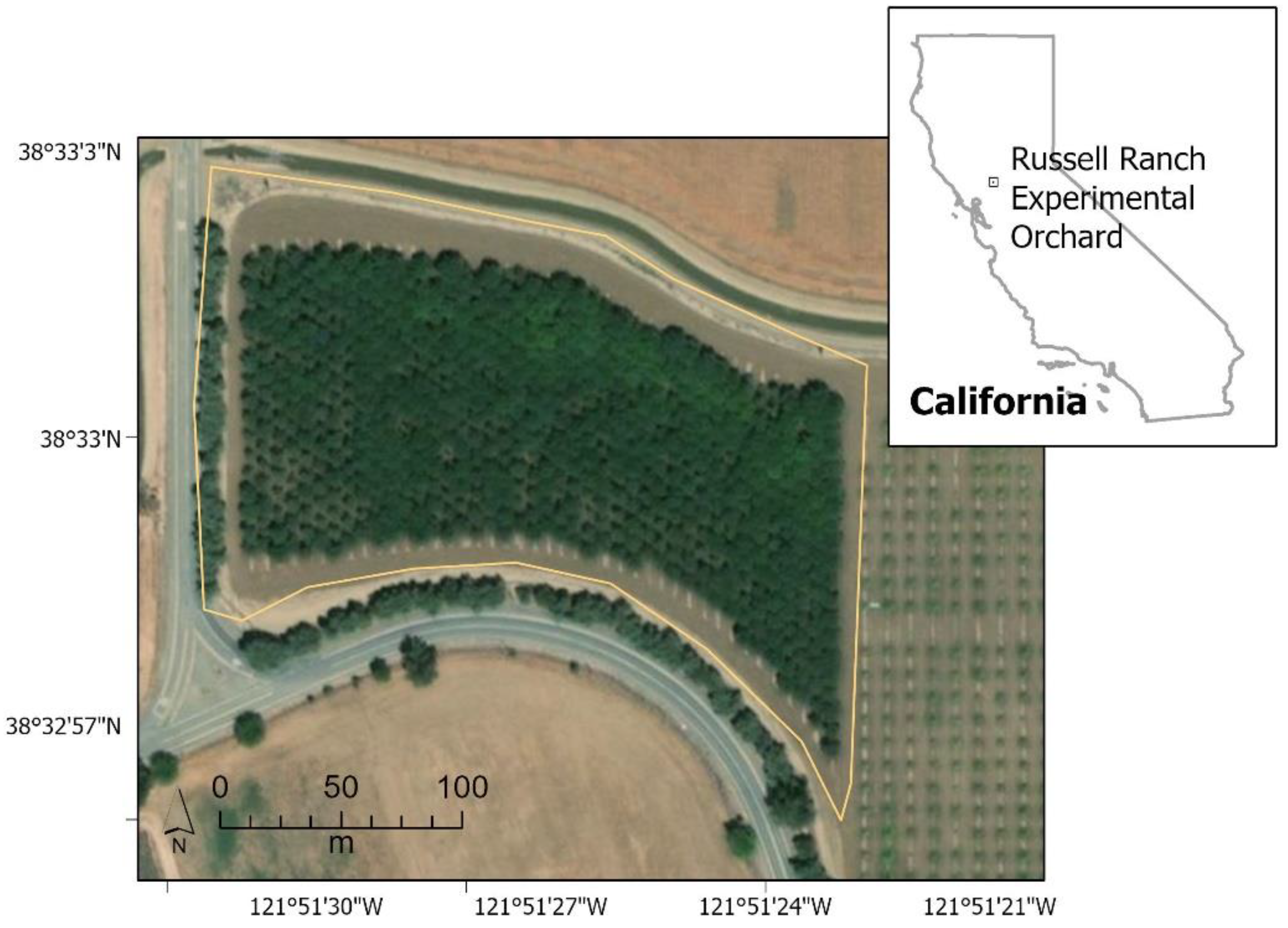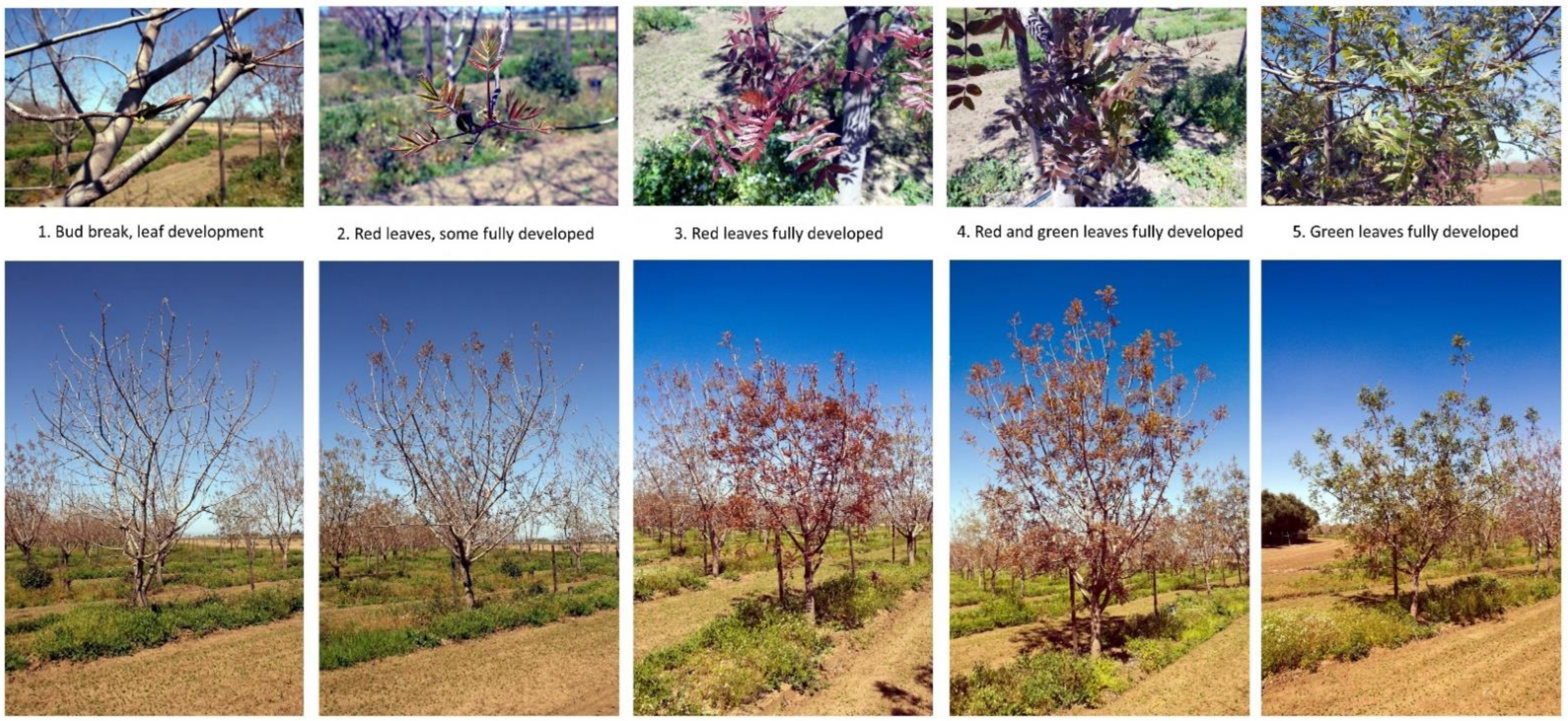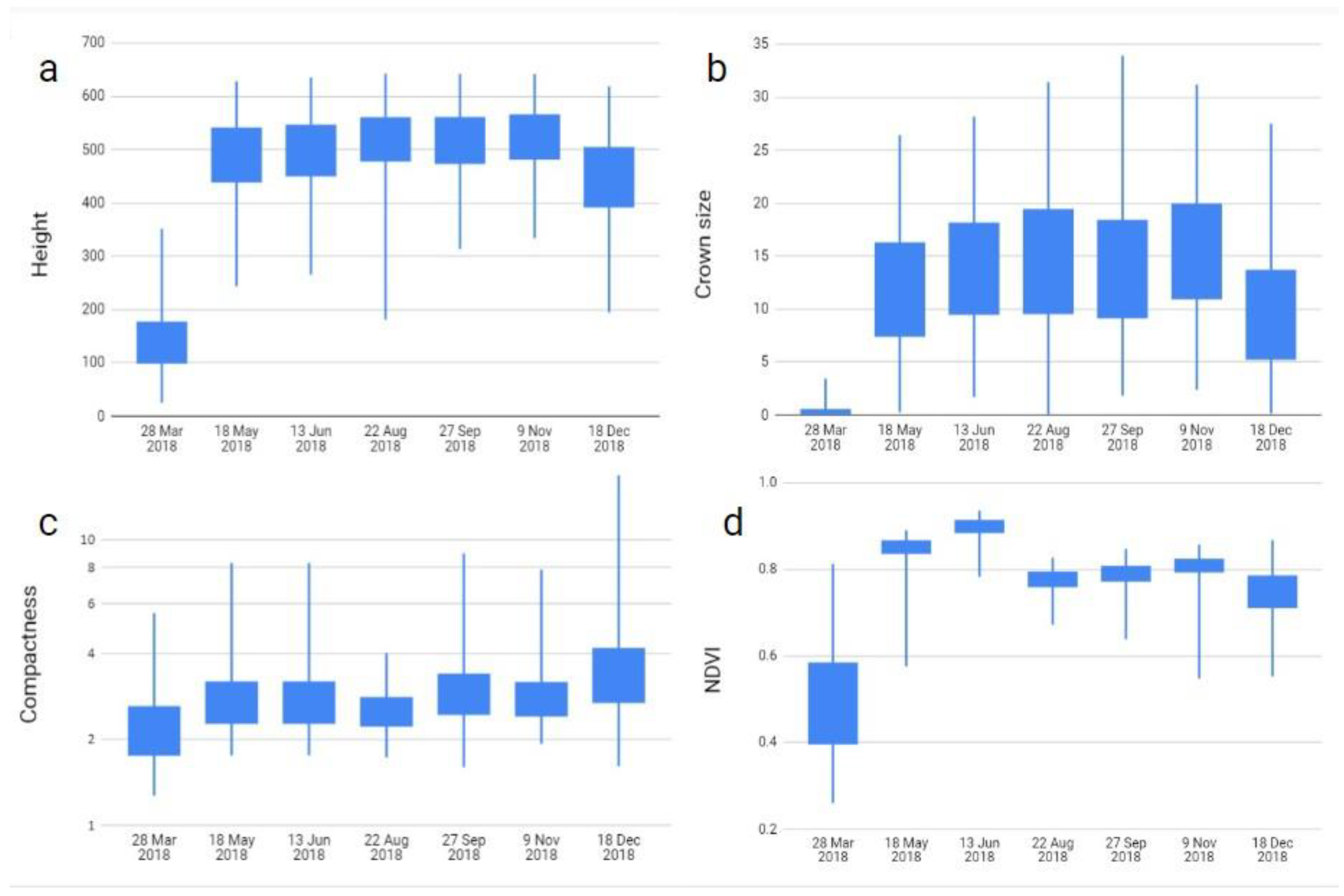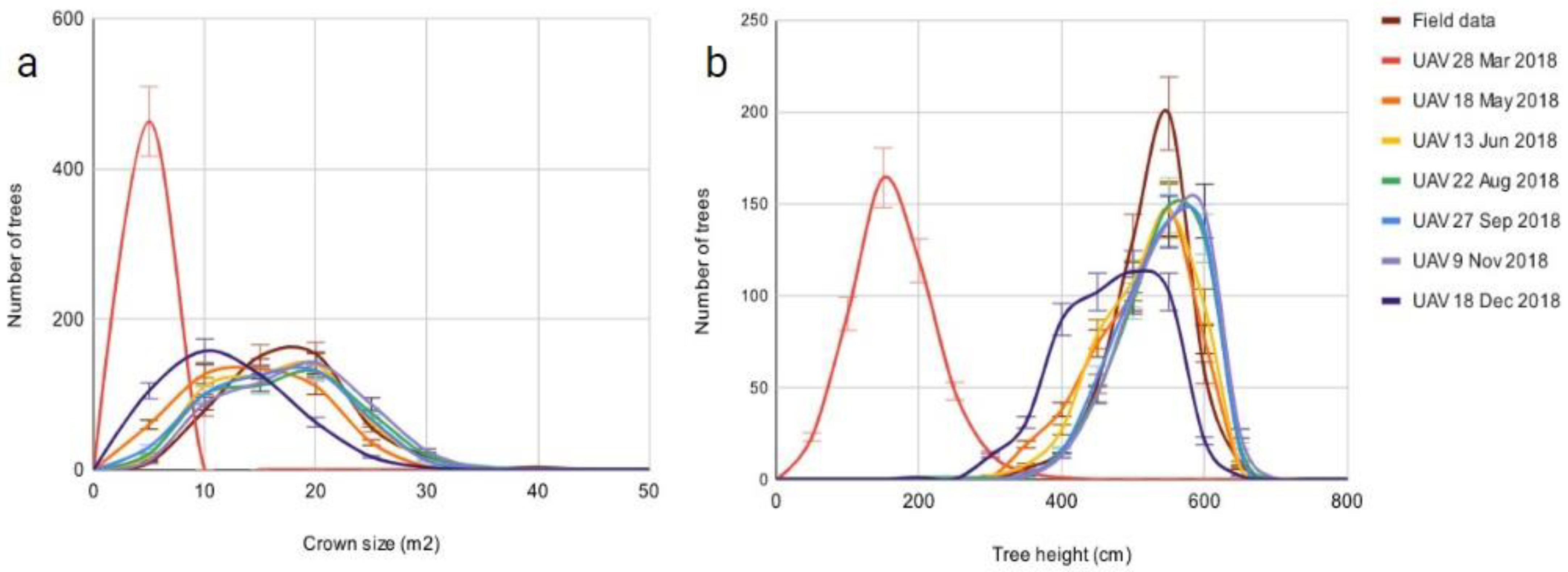Comparison between Field Measured and UAV-Derived Pistachio Tree Crown Characteristics throughout a Growing Season
Abstract
1. Introduction
- (1)
- use UAV-captured data to create a database of all 472 UCB-1 tree crowns in the orchard over the growing season using OBIA methods;
- (2)
- populate the tree database with tree characteristics measured in the field early in the growing season (i.e., tree height, trunk caliper, crown height, crown width, crown volume, and leaf development) and via UAV imagery analysis captured seven times over the growing season (i.e., crown height, crown area, crown perimeter, crown shape, and mean NDVI);
- (3)
- investigate the field-based and UAV-based datasets, and explore any predictive relationships between the UAV data across the growing season and the physical field data;
- (4)
- contribute to the growing body of knowledge about the use of UAV imagery in the monitoring and management of agricultural crops.
2. Materials and Methods
2.1. Study Area
2.2. Physical Field Data Collection
2.3. Imagery Collection and Processing
2.4. Crown Segmentation and Database Creation
2.5. Analysis of Field-Based and UAV-Based Crown Characteristics
2.6. Analysis between Field-Based and UAV-Based Crown Characteristics
3. Results
3.1. Analysis of Field-Based and UAV-Based Crown Characteristics
3.1.1. Field-Based Results
3.1.2. UAV-Based Results
3.2. Agreement between UAV- and Field-Based Data
4. Discussion
4.1. General Lessons
4.2. Leaf Development
4.3. Pistachio as a Model System
4.4. The Benefits of Using UAV Data for Orchard Management
5. Conclusions
Author Contributions
Funding
Data Availability Statement
Acknowledgments
Conflicts of Interest
References
- Moussaid, A.; Fkihi, S.E.; Zennayi, Y. Tree Crowns Segmentation and Classification in Overlapping Orchards Based on Satellite Images and Unsupervised Learning Algorithms. J. Imaging Sci. Technol. 2021, 7, 241. [Google Scholar] [CrossRef]
- Goodman, R.C.; Phillips, O.L.; Baker, T.R. The Importance of Crown Dimensions to Improve Tropical Tree Biomass Estimates. Ecol. Appl. 2014, 24, 680–698. [Google Scholar] [CrossRef] [PubMed]
- Anderson, K. Gaston Lightweight Unmanned Aerial Vehicles Will Revolutionize Spatial Ecology. Front. Ecol. Environ. 2013, 11, 138–146. [Google Scholar] [CrossRef]
- Cruzan, M.B.; Weinstein, B.G.; Grasty, M.R.; Kohrn, B.F.; Hendrickson, E.C.; Arredondo, T.M.; Thompson, P.G. Small Unmanned Aerial Vehicles (micro-UAVs, Drones) in Plant Ecology. Appl. Plant Sci. 2016, 4, 1600041. [Google Scholar] [CrossRef] [PubMed]
- Hardin, P.J.; Lulla, V.; Jensen, R.R.; Jensen, J.R. Small Unmanned Aerial Systems (sUAS) for Environmental Remote Sensing: Challenges and Opportunities Revisited. GISci. Remote Sens. 2019, 56, 309–322. [Google Scholar] [CrossRef]
- Hogan, S.D.; Kelly, M.; Stark, B.; Chen, Y. Unmanned Aerial Systems for Agriculture and Natural Resources. Calif. Agric. 2017, 71, 5–14. [Google Scholar] [CrossRef]
- Guirado, E.; Tabik, S.; Alcaraz-Segura, D.; Cabello, J.; Herrera, F. Deep-Learning Versus OBIA for Scattered Shrub Detection with Google Earth Imagery: Ziziphus Lotus as Case Study. Remote Sens. 2017, 9, 1220. [Google Scholar] [CrossRef]
- Peña, J.M.; Torres-Sánchez, J.; de Castro, A.I.; Kelly, M.; López-Granados, F. Weed Mapping in Early-Season Maize Fields Using Object-Based Analysis of Unmanned Aerial Vehicle (UAV) Images. PLoS ONE 2013, 8, e77151. [Google Scholar] [CrossRef]
- Huang, H.; Lan, Y.; Yang, A.; Zhang, Y.; Wen, S.; Deng, J. Deep Learning versus Object-Based Image Analysis (OBIA) in Weed Mapping of UAV Imagery. Int. J. Remote Sens. 2020, 41, 3446–3479. [Google Scholar] [CrossRef]
- Guo, Q.; Kelly, M.; Gong, P.; Liu, D. An Object-Based Classification Approach in Mapping Tree Mortality Using High Spatial Resolution Imagery. GISci. Remote Sens. 2007, 44, 24–47. [Google Scholar] [CrossRef]
- Cleve, C.; Kelly, M.; Kearns, F.R.; Moritz, M. Classification of the Wildland–urban Interface: A Comparison of Pixel-and Object-Based Classifications Using High-Resolution Aerial Photography. Comput. Environ. Urban Syst. 2008, 32, 317–326. [Google Scholar] [CrossRef]
- Yu, Q.; Gong, P.; Clinton, N.; Biging, G. Object-Based Detailed Vegetation Classification with Airborne High Spatial Resolution Remote Sensing Imagery. Remote Sens. 2006, 72, 799–811. [Google Scholar] [CrossRef]
- Jakubowski, M.K.; Li, W.; Guo, Q.; Kelly, M. Delineating Individual Trees from LiDAR Data: A Comparison of Vector-and Raster-Based Segmentation Approaches. Remote Sens. 2013, 5, 4163–4186. [Google Scholar] [CrossRef]
- American Pistachio Growers. Available online: https://americanpistachios.org/growing-and-harvesting/history (accessed on 23 March 2022).
- Morgan, D.; Epstein, P.L.; Ferguson, L. Verticillium Wilt Resistance in Pistachio Rootstock Cultivars: Assays and an Assessment of Two Interspecific Hybrids. Plant Dis. 1992, 76, 310–313. [Google Scholar] [CrossRef]
- Epstein, L.; Beede, R.; Kaur, S.; Ferguson, L. Rootstock Effects on Pistachio Trees Grown in Verticillium dahliae-Infested Soil. Phytopathology 2004, 94, 388–395. [Google Scholar] [CrossRef]
- Beede, R.H. Pistachio Canopy Management and Its Effect on Yield Components. In 8th Advanced in Pistachio Production; University of California: Davis, CA, USA, 2017. [Google Scholar]
- Jacygrad, E.; Preece, J.E.; Palmer, W.J.; Michelmore, R.; Golino, D. Phenotypic Segregation of Seedling UCB-1 Hybrid Pistachio Rootstock. Trees 2020, 34, 531–541. [Google Scholar] [CrossRef]
- Ferguson, L.; Reyes, H.; Sanden, B.; Grattan, S.; Epstein, L.; Krueger, B. Pistachio Rootstocks. In Pistachio Production Manual; UCANR Publications: Richmond, CA, USA, 2005; pp. 67–73. [Google Scholar]
- Tucker, C.J. Red and photographic infrared linear combinations for monitoring vegetation. Remote Sens. Environ. 1979, 8, 127–150. [Google Scholar] [CrossRef]
- Serra, J. Image Analysis and Mathematical Morphology; Academic Press: New York, NY, USA, 1982. [Google Scholar]
- Montero, R.S.; Bribiesca, E. State of the Art of Compactness and Circularity Measures. Int. Math. Forum 2009, 4, 1305–1335. [Google Scholar]
- Kameyama, S.; Sugiura, K. Estimating Tree Height and Volume Using Unmanned Aerial Vehicle Photography and SfM Technology, with Verification of Result Accuracy. Drones 2020, 4, 19. [Google Scholar] [CrossRef]
- Niu, H.; Wang, D.; Chen, Y. Estimating Actual Crop Evapotranspiration Using Deep Stochastic Configuration Networks Model and UAV-Based Crop Coefficients in a Pomegranate Orchard. In Proceedings of the Autonomous Air and Ground Sensing Systems for Agricultural Optimization and Phenotyping V., SPIE, California, CA, USA, 21 April 2020; Volume 11414, pp. 76–82. [Google Scholar]
- Maes, W.H.; Steppe, K. Perspectives for Remote Sensing with Unmanned Aerial Vehicles in Precision Agriculture. Trends Plant Sci. 2019, 24, 152–164. [Google Scholar] [CrossRef]
- Jafarbiglu, H.; Pourreza, A. A Comprehensive Review of Remote Sensing Platforms, Sensors, and Applications in Nut Crops. Comput. Electron. Agric. 2022, 197, 106844. [Google Scholar] [CrossRef]
- Barajas, E.; Álvarez, S.; Fernández, E.; Vélez, S.; Rubio, J.A.; Martín, H. Sentinel-2 Satellite Imagery for Agronomic and Quality Variability Assessment of Pistachio (Pistacia vera L.). Sustain. Sci. Pract. Policy 2020, 12, 8437. [Google Scholar] [CrossRef]
- Zhao, T.; Stark, B.; Chen, Y.; Ray, A.L.; Doll, D. Challenges in Water Stress Quantification Using Small Unmanned Aerial System (sUAS): Lessons from a Growing Season of Almond. J. Intell. Rob. Syst. 2017, 88, 721–735. [Google Scholar] [CrossRef]
- Ferguson, L.; Polito, V.; Kallsen, C. The Pistachio Tree; Botany and Physiology and Factors That Affect Yield. In Pistachio Production Manual, 4th ed.; University of California Fruit & Nut Research Information Center: Davis, CA, USA, 2005. [Google Scholar]
- Pirmoradian, M. Morphological Study of Local Pistachio Genotypes in the Isfahan Province. In Proceedings of the IV International Symposium on Pistachios and Almonds, Tehran, Iran, 22–25 May 2005; International Society for Horticultural Science: Leuven, Belgium, 2006. [Google Scholar]
- Schomaker, M. Crown-Condition Classification: A Guide to Data Collection and Analysis; Gen. Tech. Rep. SRS-102; U.S. Department of Agriculture, Forest Service, Southern Research Station: Asheville, NC, USA, 2007; 78p. Available online: https://www.fs.usda.gov/research/treesearch/27730 (accessed on 23 March 2022).
- Fawcett, D.; Bennie, J.; Anderson, K. Monitoring Spring Phenology of Individual Tree Crowns Using Drone-acquired NDVI Data. Remote Sens. Ecol. Conserv. 2021, 7, 227–244. [Google Scholar] [CrossRef]
- Pettorelli, N.; Vik, J.O.; Mysterud, A.; Gaillard, J.-M.; Tucker, C.J.; Stenseth, N.C. Using the Satellite-Derived NDVI to Assess Ecological Responses to Environmental Change. Trends Ecol. Evol. 2005, 20, 503–510. [Google Scholar] [CrossRef]
- Zeng, Y.; Hao, D.; Huete, A.; Dechant, B.; Berry, J.; Chen, J.M.; Joiner, J.; Frankenberg, C.; Bond-Lamberty, B.; Ryu, Y.; et al. Optical Vegetation Indices for Monitoring Terrestrial Ecosystems Globally. Nat. Rev. Earth Environ. 2022, 3, 477–493. [Google Scholar] [CrossRef]
- Gamon, J.A.; Field, C.B.; Goulden, M.L.; Griffin, K.L.; Hartley, A.E.; Joel, G.; Penuelas, J.; Valentini, R. Relationships Between NDVI, Canopy Structure, and Photosynthesis in Three Californian Vegetation Types. Ecol. Appl. 1995, 5, 28–41. [Google Scholar] [CrossRef]
- Kizilgeci, F.; Yildirim, M.; Islam, M.S.; Ratnasekera, D.; Iqbal, M.A.; Sabagh, A.E.L. Normalized Difference Vegetation Index and Chlorophyll Content for Precision Nitrogen Management in Durum Wheat Cultivars under Semi-Arid Conditions. Sustain. Sci. Pract. Policy 2021, 13, 3725. [Google Scholar] [CrossRef]
- Yang, H.; Yang, X.; Heskel, M.; Sun, S.; Tang, J. Seasonal Variations of Leaf and Canopy Properties Tracked by Ground-Based NDVI Imagery in a Temperate Forest. Sci. Rep. 2017, 7, 1267. [Google Scholar] [CrossRef]
- Polgar, C.A.; Primack, R.B. Leaf-out Phenology of Temperate Woody Plants: From Trees to Ecosystems. New Phytol. 2011, 191, 926–941. [Google Scholar]
- Azeez, A.; Zhao, Y.C.; Singh, R.K.; Yordanov, Y.S.; Dash, M.; Miskolczi, P.; Stojkovič, K.; Strauss, S.H.; Bhalerao, R.P.; Busov, V.B. EARLY BUD-BREAK 1 and EARLY BUD-BREAK 3 Control Resumption of Poplar Growth after Winter Dormancy. Nat. Commun. 2021, 12, 1123. [Google Scholar] [CrossRef]
- Rossi, S.; Bousquet, J. The Bud Break Process and Its Variation among Local Populations of Boreal Black Spruce. Front. Plant Sci. 2014, 5, 574. [Google Scholar] [CrossRef]
- Lechowicz, M.J. Why Do Temperate Deciduous Trees Leaf Out at Different Times? Adaptation and Ecology of Forest Communities. Am. Nat. 1984, 124, 821–842. [Google Scholar] [CrossRef]
- Bennie, J.; Kubin, E.; Wiltshire, A.; Huntley, B.; Baxter, R. Predicting Spatial and Temporal Patterns of Bud-Burst and Spring Frost Risk in North-West Europe: The Implications of Local Adaptation to Climate. Glob. Chang. Biol. 2010, 16, 1503–1514. [Google Scholar] [CrossRef]
- Liu, Q.; Piao, S.; Campioli, M.; Gao, M.; Fu, Y.H.; Wang, K.; He, Y.; Li, X.; Janssens, I.A. Modeling Leaf Senescence of Deciduous Tree Species in Europe. Glob. Chang. Biol. 2020, 26, 4104–4118. [Google Scholar] [CrossRef]
- Gan, S.; Amasino, R.M. Making Sense of Senescence (Molecular Genetic Regulation and Manipulation of Leaf Senescence). Plant Physiol. 1997, 113, 313–319. [Google Scholar] [CrossRef]
- Keskitalo, J.; Bergquist, G.; Gardeström, P.; Jansson, S. A Cellular Timetable of Autumn Senescence. Plant Physiol. 2005, 139, 1635–1648. [Google Scholar] [CrossRef]
- Richardson, A.D.; Anderson, R.S.; Arain, M.A.; Barr, A.G.; Bohrer, G.; Chen, G.; Chen, J.M.; Ciais, P.; Davis, K.J.; Desai, A.R.; et al. Terrestrial Biosphere Models Need Better Representation of Vegetation Phenology: Results from the North American Carbon Program Site Synthesis. Glob. Chang. Biol. 2012, 18, 566–584. [Google Scholar] [CrossRef]
- CRANE; Julian, C. Morphology and Reproduction of Pistachio. Hortic Rev. 1981, 3, 376–393. [Google Scholar]
- Ferguson, L.; Beede, R.; Buchner, R.; Kallsen, C.; Freeman, M.; Reyes, H.C.; Metheney, P.; Kafkas, S. California Pistachio Rootstock Trials: Final Report, 1989–1997. Cal. Pist. Ind. Annu. Rep. Crop Year 1997, 98, 60–63. [Google Scholar]
- Spann, T.M.; Beede, R.H.; Dejong, T.M. Preformation in Vegetative Buds of Pistachio (Pistacia vera): Relationship to Shoot Morphology, Crown Structure and Rootstock Vigor. Tree Physiol. 2007, 27, 1189–1196. [Google Scholar] [CrossRef][Green Version]
- Wang, Y.; Lehtomäki, M.; Liang, X.; Pyörälä, J.; Kukko, A.; Jaakkola, A.; Liu, J.; Feng, Z.; Chen, R.; Hyyppä, J. Is Field-Measured Tree Height as Reliable as Believed—A Comparison Study of Tree Height Estimates from Field Measurement, Airborne Laser Scanning and Terrestrial Laser Scanning in a Boreal Forest. ISPRS J. Photogramm. Remote Sens. 2019, 147, 132–145. [Google Scholar] [CrossRef]
- Sterenczak, K.; Mielcarek, M.; Wertz, B.; Bronisz, K.; Zajączkowski, G.; Jagodzinski, A.M.; Ochał, W.; Skorupski, M. Factors influencing the accuracy of ground-based tree-height measurements for major European tree species. J. Environ. Manag. 2019, 231, 1284–1292. [Google Scholar] [CrossRef]
- Guo, Q.; Su, Y.; Hu, T.; Guan, H.; Jin, S.; Zhang, J. Lidar Boosts 3D Ecological Observations and Modeling: A Review and Perspective. IEEE Geosci. 2020, 9, 232–257. [Google Scholar] [CrossRef]
- Ao, Z.; Wu, F.; Hu, S.; Sun, Y.; Su, Y.; Guo, Q.; Xin, Q. Automatic Segmentation of Stem and Leaf Components and Individual Maize Plants in Field Terrestrial LiDAR Data Using Convolutional Neural Networks. Crop. J. 2021, 10, 1239–1250. [Google Scholar] [CrossRef]






| Value | Tree Height (cm) | Trunk Caliper (cm) | Crown Width (cm) | Crown Height (cm) | Crown Volume (cm3) | Crown Size (m2) |
|---|---|---|---|---|---|---|
| Min | 250 | 4.5 | 127 | 190 | 3.7 | 1.6 |
| Max | 627 | 18.5 | 623 | 570 | 96.9 | 38.8 |
| Range | 377 | 14 | 496 | 380 | 93.2 | 37.2 |
| Mean | 503 | 13.8 | 381 | 433 | 38.8 | 15.1 |
| Median | 510 | 14.0 | 386 | 440 | 39.3 | 14.9 |
| UAV-Measured | 28 March | 18 May | 13 June | 22 August | 27 September | 9 November | 18 December | UAV-Measured |
|---|---|---|---|---|---|---|---|---|
| Tree height (m) | 0.057 ** | 0.532 ** | 0.549 ** | 0.468 ** | 0.548 ** | 0.533 ** | 0.001 ** | Crown size (m2) |
| Vegetation (NDVI) | 0.214 ** | 0.3 ** | 0.43 ** | 0.257 ** | 0.272 ** | 0.291 ** | 0.024 ** | Crown size (m2) |
| Vegetation (NDVI) | 0.116 ** | 0.178 ** | 0.238 ** | 0.198 ** | 0.153 ** | 0.217 ** | 0 ** | Tree height (m) |
| Tree height (m) | 0.124 ** | 0.006 ** | 0 ** | 0.028 ** | 0.006 ** | 0.001 ** | 0.015 ** | Compactness |
| Vegetation (NDVI) | 0.009 ** | 0.011 ** | 0.039 ** | 0 ** | 0.022 ** | 0.096 ** | 0.011 ** | Compactness |
| Crown size (m2) | 0.063 ** | 0.028 ** | 0.001 ** | 0.011 ** | 0.009 ** | 0 ** | 0.022 ** | Compactness |
| Field-Measured | 28 March | 18 May | 13 June | 22 August | 27 September | 9 November | 18 December | UAV-Measured |
|---|---|---|---|---|---|---|---|---|
| Trunk caliper (cm) | 0 ** | 0.746 ** | 0.774 | 0.729 ** | 0.75 | 0.765 ** | 0.005 ** | Crown size (m2) |
| Tree height (cm) | 0.15 ** | 0.631 ** | 0.674 | 0.685 * | 0.701 * | 0.707 ** | 0.157 * | Tree height (cm) |
| Trunk caliper (cm) | 0.285 ** | 0.6 ** | 0.603 ** | 0.572 ** | 0.594 ** | 0.587 ** | 0.204 ** | Tree height (cm) |
| Crown volume (m3) | 0.221 ** | 0.58 ** | 0.6 ** | 0.592 ** | 0.617 ** | 0.616 ** | 0.161 ** | Tree height (cm) |
| Crown height (cm) | 0.134 ** | 0.563 ** | 0.608 ** | 0.629 ** | 0.63 ** | 0.638 ** | 0.154 * | Tree height (cm) |
| Crown width (cm) | 0 ** | 0.577 ** | 0.639 ** | 0.613 ** | 0.598 ** | 0.657 ** | 0.004 ** | Crown size (m2) |
| Crown volume (m3) | 0 ** | 0.559 ** | 0.65 ** | 0.591 ** | 0.621 ** | 0.657 ** | 0 ** | Crown size (m2) |
| Crown size (m2) | 0.001 ** | 0.566 ** | 0.624 * | 0.605 | 0.588 * | 0.644 | 0.002 ** | Crown size (m2) |
| Crown width (cm) | 0.189 ** | 0.316 ** | 0.304 ** | 0.274 ** | 0.308 ** | 0.297 ** | 0.095 ** | Tree height (cm) |
| Tree height (cm) | 0.001 ** | 0.292 ** | 0.363 ** | 0.308 ** | 0.361 ** | 0.371 ** | 0.004 ** | Crown size (m2) |
| Crown height (cm) | 0.001 ** | 0.285 ** | 0.346 ** | 0.289 ** | 0.34 ** | 0.348 ** | 0.001 ** | Crown size (m2) |
| Crown size (m2) | 0.176 ** | 0.28 ** | 0.267 ** | 0.241 ** | 0.273 ** | 0.264 ** | 0.09 ** | Tree height (cm) |
| Crown volume (m3) | 0.056 ** | 0.016 ** | 0.013 ** | 0.013 ** | 0.032 ** | 0 ** | 0.004 ** | Crown shape |
| Crown size (m2) | 0.055 ** | 0.056 ** | 0.019 ** | 0.019 ** | 0.036 ** | 0.001 ** | 0.015 ** | Crown shape |
Publisher’s Note: MDPI stays neutral with regard to jurisdictional claims in published maps and institutional affiliations. |
© 2022 by the authors. Licensee MDPI, Basel, Switzerland. This article is an open access article distributed under the terms and conditions of the Creative Commons Attribution (CC BY) license (https://creativecommons.org/licenses/by/4.0/).
Share and Cite
Jacygrad, E.; Kelly, M.; Hogan, S.; Preece, J.E.; Golino, D.; Michelmore, R. Comparison between Field Measured and UAV-Derived Pistachio Tree Crown Characteristics throughout a Growing Season. Drones 2022, 6, 343. https://doi.org/10.3390/drones6110343
Jacygrad E, Kelly M, Hogan S, Preece JE, Golino D, Michelmore R. Comparison between Field Measured and UAV-Derived Pistachio Tree Crown Characteristics throughout a Growing Season. Drones. 2022; 6(11):343. https://doi.org/10.3390/drones6110343
Chicago/Turabian StyleJacygrad, Ewelina, Maggi Kelly, Sean Hogan, John E. Preece, Deborah Golino, and Richard Michelmore. 2022. "Comparison between Field Measured and UAV-Derived Pistachio Tree Crown Characteristics throughout a Growing Season" Drones 6, no. 11: 343. https://doi.org/10.3390/drones6110343
APA StyleJacygrad, E., Kelly, M., Hogan, S., Preece, J. E., Golino, D., & Michelmore, R. (2022). Comparison between Field Measured and UAV-Derived Pistachio Tree Crown Characteristics throughout a Growing Season. Drones, 6(11), 343. https://doi.org/10.3390/drones6110343







